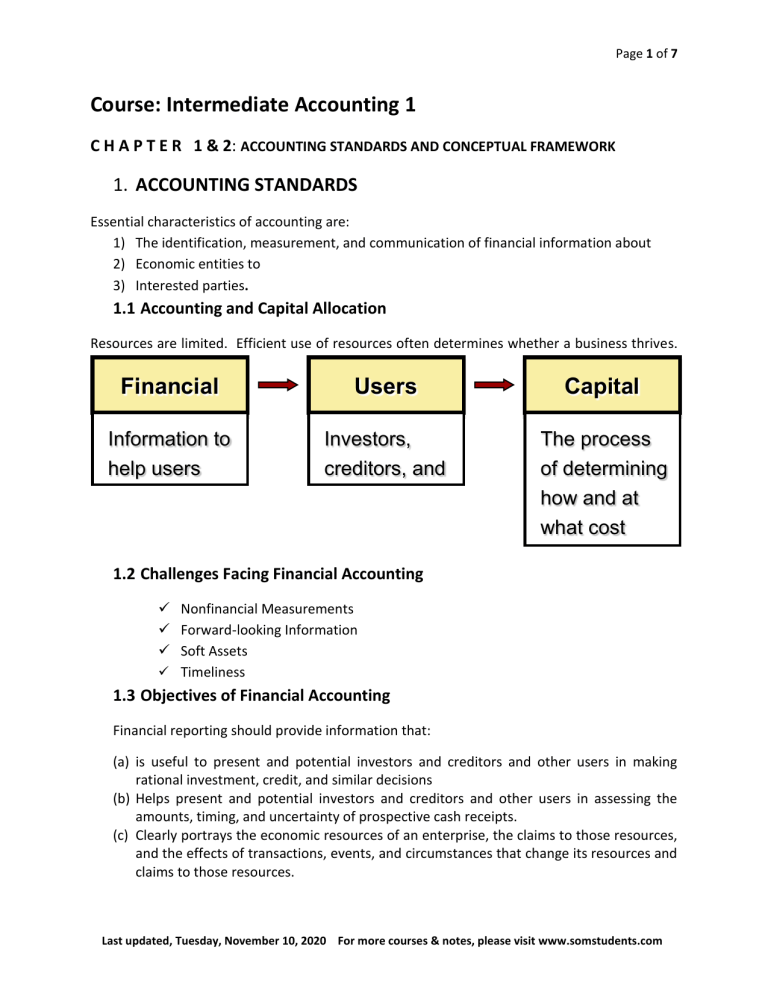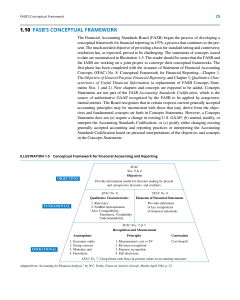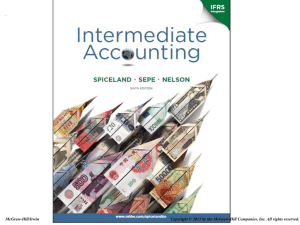
Page 1 of 7 Course: Intermediate Accounting 1 C H A P T E R 1 & 2: ACCOUNTING STANDARDS AND CONCEPTUAL FRAMEWORK 1. ACCOUNTING STANDARDS Essential characteristics of accounting are: 1) The identification, measurement, and communication of financial information about 2) Economic entities to 3) Interested parties. 1.1 Accounting and Capital Allocation Resources are limited. Efficient use of resources often determines whether a business thrives. Financial Reporting Information to help users Users Investors, creditors, and Capital Allocation The process of determining how and at what cost 1.2 Challenges Facing Financial Accounting Nonfinancial Measurements Forward-looking Information Soft Assets Timeliness 1.3 Objectives of Financial Accounting Financial reporting should provide information that: (a) is useful to present and potential investors and creditors and other users in making rational investment, credit, and similar decisions (b) Helps present and potential investors and creditors and other users in assessing the amounts, timing, and uncertainty of prospective cash receipts. (c) Clearly portrays the economic resources of an enterprise, the claims to those resources, and the effects of transactions, events, and circumstances that change its resources and claims to those resources. Last updated, Tuesday, November 10, 2020 For more courses & notes, please visit www.somstudents.com Page 2 of 7 1.4 Need to Develop Standards Various users need financial information The accounting profession has attempted to develop a set of standards that are generally accepted and universally practiced. Financial Statements Balance Sheet Income Statement Statement of Stockholders’ Equity Statement of Cash Generally Flows Note Disclosure Accepted Accounting Last updated, Tuesday, November 10, 2020 For more courses & notes, please visit www.somstudents.com Page 3 of 7 1.5 Parties Involved in Standard Setting Three organizations: Securities and Exchange Commission (SEC) American Institute of Certified Public Accountants (AICPA) Financial Accounting Standards Board (FASB) 1.5.1 Securities and Exchange Commission Established by federal government in 1933 Accounting and reporting for public companies Encouraged private standard-setting body SEC requires public companies to adhere to GAAP SEC Oversight Enforcement Authority 1.5.2 American Institute of CPAs National professional organization 1.5.3 Financial Accounting Standards Board Established 1973 Mission to establish and improve standards of financial accounting and reporting 1.6 Generally Accepted Accounting Principles Those principles that have substantial authoritative support. Major sources of GAAP are: FASB Standards, Interpretations, and Staff Positions APB Opinions AICPA Accounting Research Bulletins 1.7 Issues in Financial Reporting Accounting standards are as much a product of political action as they are of careful logic or empirical findings 1.8 International Accounting Standards Two sets of standards accepted for international use: U.S. GAAP, issued by the FASB International Financial Reporting Standards (IFRS), issued by the IASB Last updated, Tuesday, November 10, 2020 For more courses & notes, please visit www.somstudents.com Page 4 of 7 FASB and IASB recognize that global markets will best be served if only one set of GAAP is used. 2. CONCEPTUAL FRAMEWORK 2.1. The Need for a Conceptual Framework To develop a coherent set of standards and rules To solve new and emerging practical problems 2.2. Development of Conceptual Framework The FASB has issued six Statements of Financial Accounting Concepts (SFAC) for business enterprises. SFAC No.1 - Objectives of Financial Reporting SFAC No.2 - Qualitative Characteristics of Accounting Information SFAC No.3 - Elements of Financial Statements (superseded by SFAC No. 6) SFAC No.5 - Recognition and Measurement in Financial Statements SFAC No.6 - Elements of Financial Statements (replaces SFAC No. 3) SFAC No.7 - Using Cash Flow Information and Present Value in Accounting Measurements 2.3. Conceptual Framework The Framework is comprised of three levels: 2.3.1. First Level = Basic Objectives Useful in investment and credit decisions Useful in assessing future cash flows About enterprise resources, claims to resources, and changes in them 2.3.2. Second Level = Qualitative Characteristics and Basic Elements a) Relevance : Making a difference in a decision. Predictive value Feedback value Last updated, Tuesday, November 10, 2020 For more courses & notes, please visit www.somstudents.com Page 5 of 7 Timeliness b) Reliability Verifiable Representational faithfulness Neutral - free of error and bias c) Comparability Information that is measured and reported in a similar manner for different companies is considered comparable. d) Consistency When a company applies the same accounting treatment to similar events from period to period. e) Understandability A company may present highly relevant and reliable information, however it was useless to those who do not understand it. 2.3.3. Third Level = Recognition and Measurement Concepts 2.3.3.1 Assumptions 1. Economic entity company keeps its activity separate from its owners and other businesses. 2. Going concern company to last long enough to fulfill objectives and commitments 3. Monetary unit money is the common denominator 4. Periodicity company can divide its economic activities into time periods 2.3.3.2 Constraints 1. Materiality an item is material if its inclusion or omission would influence or change the judgment of a reasonable person 2. Conservatism when in doubt, choose the solution that will be least likely to overstate assets and income. 3. Cost Benefit the cost of providing the information must be weighed against the benefits that can be derived from using it 4. Industry Practice the peculiar nature of some industries and business concerns sometimes requires departure from basic accounting theory. Last updated, Tuesday, November 10, 2020 For more courses & notes, please visit www.somstudents.com Page 6 of 7 2.3.3.3 Principles Measurement – The most commonly used measurements are based on historical cost and fair value issues Historical cost provides a reliable benchmark for measuring historical trends. Fair value information may be more useful. Recently the FASB has taken the step of giving companies the option to use fair value as the basis for measurement of financial assets and financial liabilities. Reporting of fair value information is increasing. a) Revenue Recognition - generally occurs (1) when realized or realizable and (2) when earned. Note: Revenue should be recognized in the accounting period in which it is earned (generally at point of sale) b) Expenses Recognition: Expenses should be recognized when incurred not matter when paid (accrual basis) c) Full Disclosure – providing information that is of sufficient importance to influence the judgment and decisions of an informed user. Provided through: Financial Statements Notes to the Financial Statements Supplementary information Note: The FASB and the IASB have agreed on a joint project to develop a common and improved conceptual framework Last updated, Tuesday, November 10, 2020 For more courses & notes, please visit www.somstudents.com Page 7 of 7 Last updated, Tuesday, November 10, 2020 For more courses & notes, please visit www.somstudents.com


